Sydney Architect Howard Joseland (1860-1930)
From Wikipedia, the free encyclopedia
[Previous page:
Rippon Grange, Wahroonga Next page: ]
 |
| Howard Joseland, architect, was also the founder and the first Secretary of the Rod Fishers' Society. |
|
 |
| Malvern, Joseland's home at 41 Burns Road, Wahroonga |
|
Howard Joseland (1860-1930) was an English architect who migrated to Australia and pursued a successful and influential career there.
Early life
Richard George Howard Joseland was born on 14 January 1860 at Claines, Worcestershire, England.
- In the early days of his career, he was articled to the Haddon Brothers at Hereford, but moved to London in 1881.
- There, he obtained a position as assistant to George Robinson in the architectural company George Trollope and Sons.
- In
time, his health suffered as a result of overwork, and he was advised
to migrate to a more temperate clime. He went to New Zealand, where he
worked on the railways for six months.
- He then moved to Sydney, Australia, in 1888, where he married Alice Taylor.
Career in Australia
In Sydney, Joseland met
Walter Liberty Vernon,
another English architect who had migrated to Australia for health
reasons. The two architects joined forces and entered a competition to
design a model suburb [Centennial Park?]. It was the first of several
projects they would work on together. In 1890, Vernon became
New South Wales Government Architect, as a result of which he handed his private practice over to Joseland.
Career in Australia
- Joseland had relatively little work during the Depression of
the early 1890s; The practice took on a variety of commissions,
including commercial buildings, but Joseland's clientele was
predominantly well-off people who required comfortable homes.
- Many of them were moving into the new residential areas in Sydney's north, where suburbs like Wahroonga and Warrawee developed. Joseland is credited with designing something like nineteen homes in these areas.
- His output included his own home, Malvern, which he built in 1900 in Burns Road, Wahroonga.
- He designed it in the Federation Bungalow style, featuring a prominent veranda to create shade.
- From
1914 to 1919, Joseland conducted a solo practice before joining forces
with Glynn Gilling, another young English architect who had migrated to
Australia.
 |
| 1900 Coolabah, 39 Burns Road Wahroonga |
- Joseland
retired in 1929, selling the business to Gilling, who retained the
business name Joseland and Gilling. Joseland was active in various
community activities and musical societies, as well as being a keen
fisherman and author of the book Angling in Australia and Elsewhere, which was published in 1921.
- He also found time to visit England twice with his wife Blanche. He died of cancer in the eastern Sydney suburb of Darlinghurst on 20 July 1930, and was buried at South Head Cemetery in another eastern Sydney suburb, Vaucluse.
Influence
Joseland was one of the earliest architects in Australia to reject the
Victorian architectural styles that had developed in England and which
had little relevance to the Australian climate.
- He wrote a magazine article, Domestic Architecture in Australia (published in 1890), in which he advocated architectural styles that were suitable for the local climate.
- Like Walter Liberty Vernon, he favoured the styles of the
Federation era (1890-1915) and actually contributed to the development
of the Australian version of the Queen Anne style, which ultimately became the most popular residential style in Australia in the first decade of the 20th century.
- This latter style had arrived in Australia in 1885 with the construction of Caerleon, Bellevue Hill; its influence can be seen strongly in the homes Joseland designed for his clientele, along with the Arts and Crafts style that was also popular.
Joseland's Houses
1891 Mount Alverna, Burns Road, Wahroonga: 49-51 Burns Road and 10A Water Street
"The original residence 'Greystanes', (was) designed by renowned local
architect Richard George Howard Joseland, (and) was built in 1890 from
Scottish sandstone and its large stone arches are a dominant feature."
 |
 |
- "The design is a particularly fine example of the architectural
idiom which expresses the transition from High Victorian style to
Australian Federation style, with the two-storey verandah, its soaring
chimneys, gables and bays arranged asymmetrically being typical of this
style.
- The house, trees, gates, and the Burns Road fence are noted on the National Heritage List. (Mt Alverna (Friary & Retreat House)
- Mount Alverna was built for ophthalmic surgeon Dr Francis Antill Pockley.
- The property become a retreat and monastery for the Franciscan Order from the 1950's to the 1980's.
- Sold for $4.6 million, Mt Alverna, Burns Rd, Wahroonga... Seller: Daley, Buyer: Simon 1999 (THE TOP 200 PRESTIGE HOMES)
- The original 13 acres of land was subdivided in 1987 and Mount Alverna now comprises 6,800 square metres of park-like grounds."
"Mount Alverna has grand vistas across sweeping lawns of specimen trees, palms, and some areas of mass plantings."
- "Mount Alverna has some of the oldest and tallest trees in
Wahroonga. Some of the heritage-listed trees include two very large
Bunya Bunya Pines (Araucaria bidwillii), Brush Box (Lophostemon
confertus), Chestnut (Castanea sativa), several Plane trees (Platanus x
hybrida), and others lining the Burns Road frontage, Deodar Cedar
(Cedrus deodara) by the porte cochere, species of Palms (singly and in
groups) especially down the driveway, and Turpentine (Syncarpia
glomulifera) on the adjoining property that shares the Water Street
entrance." See the very informative Wahroonga Heritage Organisation page
at http://www.wahroonga.org/mount_alverna.htm
1894 Westholme, 1 Water Street, Wahroonga.
 |
 |
 |
| Dining Room with Fretwork Arch |
|
 |
| Living room with timber trim, ceiling |
|
1894 Mananga, Princes Highway Berry NSW.
- Believed to have been designed by Joseland (very probable, see his biography:..."He
had little or no work in 1897, although on 6 April he married Blanche
Augusta Hay at Coolangatta near Berry; her family was connected with the
(David) Berry estates, on which Joseland had first done work in 1892.")
- Built 1894 for the Stuart Family by John Hay who was the manager of Alexander Berrys Coolangatta estate.
- "...built in 1894 as a dairy farm, Mananga with its Victorian Design and complex gables and verandahs."
- (Despite claims, this property is not a heritage listed item.)
- This property operates as a guest house:
"...set on 5 acres of magical gardens, views and paddocks, this magical
home is for holiday lets, a quick walk into the Historic town of Berry,
7 minute drive to beaches and 15 minutes to Kangaroo Valley, wide full
verandahs and state of the art facilities..."
 |
| view of homestead |
|
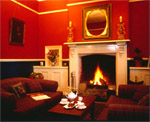 |
| guest lounge room |
|
 |
| camellia room |
|
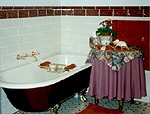 |
| cast iron restored bath in en suite |
|
1895 Lynburn Princes Highway Bomaderry.
 |
| Lynburn Timber Federation Residence |
Built 1895 by George Muller for the widow of Henry Morton, manager of
the David Berry Estate near Nowra, and Mayor of Numbaa 1868 to 1895.
Still lived in by the Morton Family (?)
- "Lynburn (is) an outstanding timber Federation
house by noted Sydney architect Howard Joseland which incorporates
several interesting and unusual design features. The house is of high
integrity. Special local historical interest as an employer-provided
house on the former Berry Estate." "An ornate Federation residence with
unusual arrangements of gables and skillion-roofed verandahs."
- "There are two front gabled projections; one interrupts the verandah; the other projects over it.
- Construction
is of weatherboard with unusual timber decoration to gable ends. There
is a complex slate roof, including skillion verandah, terracotta ridge
capping and apex ornaments and tall brick chimneys, one of which is
constructed on the diagonal.
- There is a faceted bay window, with
stained glass panes, under one of the front gables; and a verandah with
a striking fretwork fringe under the other. Brackets to verandahs are
large.
- The interior joinery is cedar and although a fire in 1981
seriously damaged the roof the integrity of the interior woodwork was
mainly preserved including part of the original lathe and plaster
ceilings.
- Features of the interior are 6 Italian marble
fireplaces, 3 in bedrooms of ornate design, 1 each in the Dining Room,
Drawing Room and Library. The grounds contain many magnificent mature
trees. The Cedar of Lebanon at the gate and a Virginian Swamp Cyprus on
the south side of the drive date back to the 1890s. Condition: The
exterior was authentically restored after the 1981 fire." - NSW Heritage Council
1896 Midhope, 60 Burns Road, Wahroonga.
Built 1896 for Sir James Murdoch, then became St Edmund's School for Children with Special Needs.
- St Edmund’s School, including the house “Midhope”, at 60 Burns
Road, corner Wahroonga Avenue, was established by the Christian Brothers
in 1950s, originally as a school for blind boys, now catering to
children with a range of special needs;
- Listed by the National Trust
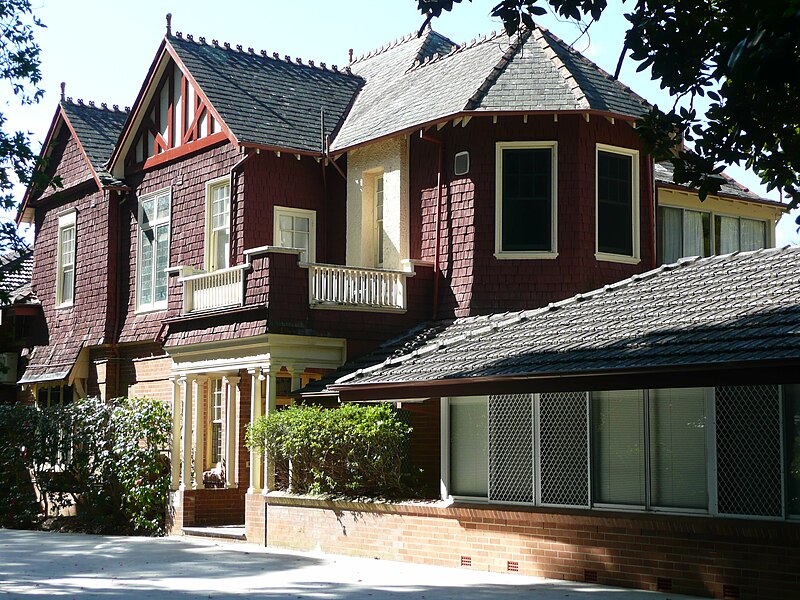 |
| St Edmund’s School, including the house “Midhope”, at 60 Burns Road |
Images held by the State Library of NSW
Group 2: Distinctive homes and gardens. Wahroonga, N.S.W. Australia [Album view]
Group 3: At Wahroonga, N.S.W. Australia. Homes and gardens of the affluent [Album view]
 |
 |
 |
| "Midhope" Home of Sir James Murdoch, Burns Rd |
The Fernery, "Midhope" Burns Rd |
"Midhope" Home of Sir James Murdoch, |
1898 Rippon Grange: 35 Water Street Wahroonga
A Two storey Federation Queen Anne house, erected in 1898
 |
| Rippon Grange, 35 Water Street Wahroonga |
|
 |
| Waterbrook proposed new hospital use for Rippon Grange.jpg |
|
1899 Redleaf, Redleaf Avenue, Wahroonga.
- Built in 1899 for W.G. Parish in Queen Anne style, considered
an important example of Joseland's work. Has Local Government Heritage
listing.
"
Redleaf is a
substantial brick two-storey residence built for W.G.Parish of the
Sydney legal firm Parish Patience and McIntyre. "The house was one of
the first generation of houses built in Wahroonga with the coming
railway.
- It was designed in 1899 in the Federation Queen Anne style with
arts and crafts details. The design was avant-garde in its time, and
the house is now rare for the high integrity of its interiors,
particularly the living area and the kitchen wing.
- Characteristics of the style present in Redleaf
are the prominent flying gables with half-timbered effects, over
projecting bay windows with leadlight casements. There is a notable
arched porch with stone trims." NSW Heritage Branch
37-41 Burns Road Wahroonga...
- 1900 Craignairn, 37 Burns Road, Wahroonga. Built for Walter Strang.
- 1900 Malvern 41 Burns Road, Wahroonga, his own home, where he lived for over 20 years.
- 1900 Coolabah,
39 Burns Road Wahroonga "Beautiful heritage listed turn of the century
single level residence of grand proportions. Set in magnificent 3,275m
of private park like grounds with grass tennis court, heated swimming
pool and plenty of room for children to play." For Sale for $4.9 Million
- See Wahroonga NSW Heritage for more details
Three Heritage Houses by Howard Joseland at 37-41 Burns Road Wahroonga
 |
| Craignairn, 37 Burns Road, Wahroonga |
|
 |
| Coolabah at No 39 Burns Road Wahroonga |
|
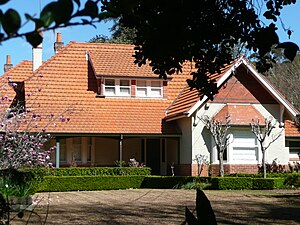 |
| Malvern, Joseland's home at 41 Burns Road, Wahroonga |
|
"
Architect Howard Joseland who designed
Craignairn for Walter Symington Strang in 1909 was (his) neighbour and friend.
- On 8 February 1899 Joseland and Strang had purchased adjoining lots in Burns Road. A few days later Joseland began preparing plans for both Coolabah at No 39 for Strang and his own house Malvern at No 41 Burns Road, Wahroonga .
- When
Strang decided to build a new residence he chose the adjoining lots of
land on the corner of two main roads, Burns Road and Cleveland Street.
- The
architectural firm Joseland and Vernon designed the house and were also
commissioned to design the garden, trellis-work and pergola.
- This group of three adjoining residences Craignairn, Coolabah and Malvern designed by Joseland is unique.
- Jennifer Harvey for Ku-ring-gai Historical Society Inc.
1900 Eldinhope, 47 Burns Road, Wahroonga.
- "Eldinhope was designed by Howard Joseland for Miss Florence Hooke.
- Eldinhope, operated from 1901 until 1932 at 47 Burns Road, then in the St Andrew's Church of England Hall until 1939.
- Designed for Florence Hooke circa 1900, became Eldinhope School for Girls in 1901.
 |
| Eldinhope 47 Burns Road Wahroonga |
- The
home was completed c.1900 and the Eldinhope School for Girls began in
1901. Miss Hooke was assisted by her two sisters, Edith (who had
previously started Wenona College), and Bessy, who taught music.
Florence herself taught art. Until 1910 it was for day-girls only, but
in October 1910, boarders were enrolled and lived at "Malto Ende", on
the corner of Lochville Street and Grosvenor Road.
In 1932 Miss Hooke sold the school to the Misses Robinson of Lindfield,
who then conducted the school in the hall of St. Andrews Church. The
school closed at the end of 1939.
- "The house still exists today and has been restored to excellent condition." - http://www.wahroonga.org/47_burns.htm
1906 Illowra 472 Princes Highway Bomaderry NSW,
- Built in 1906 for Mark F Morton. member for Willondilly in the NSW legislative assembly 1901 till 1938
- "Designed
by the renowned architect Howard Joseland, this substantial Edwardian
residence was built in 1906 for Mr M.F. Morton, a member of the
Legislative Assembly who represented Shoalhaven for some 38 years. The
property remained in the hands of various Morton family members until it
was purchased by the current owner 10 years ago. During the past decade
Illowra has been faithfully restored and extended and the extensive
grounds have been carefully tended."
 |
 |
- "Long regarded as one of the Shoalhaven's finest historic
residences "Illowra" was designed by Howard Joseland and built in 1906
for the late MF Morton, MLA. Beginning in 1995 a restoration and
extension program began and with meticulous attention to detail was
completed over a decade further enhancing the grace and elegance of the
Edwardian masterpiece. - http://www.stayz.com.au/30397
- "The house is renowned not only for its timeless appeal but also for the decades-old gardens.
In fact, Mark Morton is best remembered for his contribution to
conservation resulting in Morton National Park being dedicated to his
memory." - South Coast Register Bomaderry’s $1m home 21 Nov, 2001
- For sale 2001 for $950,000: House 4 bedrooms, 3 bathrooms, office, parking, views, guest suite, pool, floodlit tennis court
Built 1906, renovated 1990s, Land 5,122 square metres. Inspect by appointment,
Agent Raine & Horne Berry, 44642399
References
- ^ Six of the Best Architects of Ku-Ring-Gai, Zeny Edwards (pub. Zeny Edwards) 1998, p.33
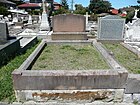 |
| Joseland's grave at South Head Cemetery |
- ^ A Pictorial Guide to Identifying Australian Architecture, Richard Apperly (Angus and Robertson) 1994, p.147
- ^ The Federation House, Hugh Fraser (New Holland) 2002, p.24
- ^ The Heritage of Australia, Macmillan Company, 1981, p. 2/111
































No comments:
Post a Comment